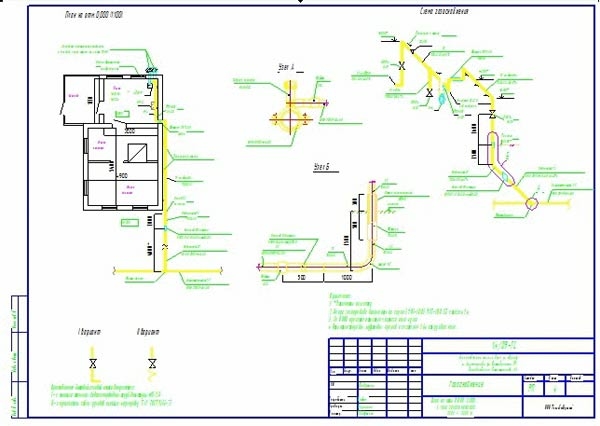Connecting gas to a private house according to the new rules eliminated many of the obstacles that the owners faced. Due to the monopolization of the sphere, there were no exact prices, the cost was inaccessible to most citizens. After the changes made to the legislation, the installation time was reduced, the price level became acceptable.
But it is still a very troublesome process that takes a lot of time and effort. It is required to collect the necessary documents, make a project, sign a work contract, coordinate all issues with interested organizations. Knowing the sequence of steps, the owner is guaranteed to get rid of unnecessary worries and misunderstandings, and speed up the gasification process at home.
Connection procedure - documentation and practical implementation
First of all, they turn to the owner of the gas pipeline located nearby (usually this is the local branch of the company) to find out the possibility of tie-in. If a positive response is received, an application for the issuance of technical conditions is written. It contains information about the applicant: full name, full address, including postal address, telephone number. The planned gas consumption per hour is indicated.
Together they submit the necessary documents: a copy of the passport and a certificate of ownership of the land. It is required to provide a plan of the territory where the summer cottage is located, with reference to the surrounding area. Calculations of gas consumption are given. They will not be needed if the area of \u200b\u200bthe house does not exceed 250 m2, this is no more than 5 m3. In other cases, specialists will help to calculate, but for an additional fee.
Resolving formatting issues
The rules provide that on the site and in the building, the execution of all work is entrusted to the owner, and outside it - to the gas distribution company. Consequently, the owner performs actions aimed at preparing the consumer network and equipment for connection. Only an organization that has a license and permission can act as a contractor. It performs all connection activities, which are fixed in the signed agreement and specifications.
The first step - the supplier company develops technical conditions. They contain the following information:
- the maximum allowed hourly gas consumption;
- time for connection work;
- the duration of the TU.
Within two weeks, the organization sends the applicant a draft specification. A refusal is also possible if experts find out that the building is located at a distance exceeding 200 meters from the gas pipeline. Motivation in the price of works - several million rubles for one person. The way out is cooperation with other residents. If there are enough of them, the pipe will be laid free of charge - this is provided for by the new rules.
If the owner of the house agrees with the technical conditions, he submits an application to the gas office, in which he expresses a desire to draw up an agreement regarding the connection. Within a month, the organization sends two copies of the agreement and updated technical conditions in response. The final version contains, in addition to the initial, additional information:
- the gas pipeline from which it is required to bring the pipe to the site is indicated;
- limits of pressure fluctuation in the consumer network;
- standards for hourly gas consumption;
- pipe diameter and material;
- the obligation of the customer to equip the facility with a meter.
After studying the contract, if the homeowner agrees, he signs the documents, sends one copy to the company. The agreement provides:
- distribution of responsibilities of the owner of the site and the organization;
- deadlines;
- delimitation of property between Gorgaz and the owner;
- cost and payment procedure;
- liability for non-compliance.
The owner orders a gasification project for the house. This is the most expensive procedure. An agreement is concluded with an organization that has the right to perform the relevant work. You can save money by contacting a gas company, but they take a long time to realize: it takes six months or more. If you need it urgently, make an order in a private company - it will be faster, but much more expensive.

A plan of the building, a list of devices planned for installation, and proposed locations are provided. Payment is made for the preparation of documentation and coordination with the services that own the various communications with which the gas pipeline intersects. The finished document must be approved by the distribution company if the contractor is taken from outside.
When choosing it, they stop at the one whose services are not only cheaper, but also assume the responsibility of coordinating the project with various organizations and its approval by the gas company. This is important - bureaucratic red tape can take a lot of time and nerves. You should listen to the opinion of the gas company - who they recommend, stop there. There will be fewer problems in the future.
Implementation of the gas supply project
The applicant makes the first payment according to the schedule and the turn of practical actions comes. Gas service specialists are laying a pipe from the main to the site. The cost now fluctuates between 2,000 and 5,000 rubles per meter, but the presidential program for gasification of a private house makes it possible in rural areas to do this for free.

Next comes the turn of installation and construction work in the house. It is preferable to take as a contractor a team from an organization with which an agreement was concluded on the supply of a pipe from the main gas network. It is registered, licensed and responsible for the commissioning of the site, so it solves all the problems that arise. But gas distribution companies are not particularly interested, this is not part of their duties. They are often very busy and you can expect a long time.
It is allowed to involve a third-party construction and installation organization that has an official permit for such activities. You can ask the gas workers who they recommend. Their technical supervision service accepts the work, so they know the organizations with the right to carry out the installation. Such firms often have not only installation teams, but also a design bureau. If you order from them the preparation of documentation for the gasification of the house and installation, you can significantly save on the total cost - up to 30%.
When a verbal agreement is reached, the contract is signed. It specifies the obligations and guarantees of the contractor:
- terms of work, cost and calculation procedure;
- compliance with fire safety rules by installers;
- preparation of executive and technical documentation after completion of work.
An application for connection is being written. It contains information about the owner and the object, the norms for the planned gas consumption, the initial data of the technical specifications. Required documents are attached:
- site plan with reference to the terrain;
- a topographic map showing the location of all communications;
- property and personal documents;
- calculation of the maximum gas consumption if it exceeds 5 m3 per hour.
When all work is completed, they are accepted by a commission consisting of the customer, representatives of the regional gas service and the contractor. This is done within no more than one month. At the time of acceptance, all equipment must be installed and connected. A test run is made, the operation of the installations is checked, a possible leak. If there are no comments, a technical supervision receipt is issued, which must be paid.

The installation organization, on the basis of the conclusions of the commission, draws up and transfers to the company all the technical documentation, where it remains in storage. When the bureaucratic procedures are over, for three weeks a representative of the gas service installs seals on the meter. Despite all the hassle and money, it is still worthwhile to install gas in a private house in order to enjoy the benefits of civilization.
Connection price and benefits
From 01.03.2014 new rules for connecting residential buildings to the gas distribution system are in force. They contain the old norms and changes have been made that relate to the timing of work and cost. Thanks to this, the connection has become more profitable, takes less time.
Prices vary, depending mainly on the remoteness of the object, but on average you will have to pay:
- for filling out an application, obtaining a permit and primary documents - from 8 to 50 thousand rubles;
- the production of the project will cost 3-20 thousand;
- laying a pipe from the main to the facility - 2-5 thousand per meter;
- tie-in to the gas pipeline - from 10,000 to 15,000 rubles;
- a readiness check by technical supervision costs an average of 2,000.
In the regions there is a significant fluctuation in prices. For example, in the Moscow region it is 400-500 thousand for all work. The cost is determined by the distance from the capital. In the Leningrad region, 300 thousand rubles are enough, and in the Nizhny Novgorod region - 150-200 thousand. The cheapest gas pipe in a private house will cost in the European part of Russia, an average of 100 thousand rubles. Beyond the Urals, the situation is somewhat different; many settlements are located at a considerable distance from industrial centers and gas pipelines.

The region of the Far East, where there are very few highways, is problematic in this respect. Even if the main pipe is nearby, for a tie-in to a gas pipeline for an amount less than 200 thousand, one cannot count. Equipment is imported from nearby foreign countries, which affects prices. The diversity of the climate also prevents the application of standards that are used in other regions.
There are many benefits in Russia, but at the state level they do not apply to gasification. The federal government transferred this right to the local. In the regions, first of all, veterans of the Second World War, the disabled, combatants, single mothers (fathers) receive financial assistance for connection. The Leningrad region can be cited as an example: here 70,000 rubles are allocated from the budget for ordinary citizens, and 110,000 rubles for beneficiaries.
Support for the population to connect to the gas supply networks of a private house is carried out differently in each region. Some provide preferential targeted loans, others provide monetary compensation. To get it, apply. All costs do not overlap, but 50% can be counted on. The categories of citizens who are granted such benefits are determined by local authorities. To find out about their rights, contact the relevant administration services.
The presidential program plays an important role in rural areas. It provides:
- construction and reconstruction of gas distribution networks;
- the use of energy-saving technologies for installation;
- increasing the efficiency of the use of natural resources.
Companies are guided by federal law, the percentage of residents covered by gasification is increasing. The new rules provide for the possibility for rural residents to submit a collective application for the installation of pipes from the main to the plots. If it is satisfied, the supply to the settlement is free of charge. Property owners connect to the network at their own expense.
Gas appliances for a private house
When submitting documents, it is desirable to know what equipment will be used. This is especially true for the boiler. The power is chosen, keeping in mind that for heating every 10 m2, 1 kW is required, and if hot water is used, an additional 25%. According to the type of installation, there are floor and wall boilers. They differ in the principle of action:
- non-volatile;
- consuming electricity;
- condensation.
Mounted on the base, they have a large choice of power, heat rooms of various sizes, and a boiler for hot water can be connected to them. Compact, wall-mounted, equipped with an expansion tank and a circulation pump.

The operation of non-volatile gas equipment is based on the principle of natural circulation, these are the simplest devices. They are connected to pipelines of large diameter, the possibility of flexible adjustment of the air temperature in the rooms is excluded. The room where the device with an open chamber for gas combustion is installed must be equipped with tidal and exhaust ventilation, a chimney.
Volatile boilers have a closed expansion tank, a pump and a fully automated control system. This is a kind of mini boiler room. It needs a constant supply of electricity to run smoothly. The requirements for its quality are quite strict: the voltage in the network must be stable, differ from 220 V by no more than 10%. In rural areas with constantly changing network parameters, a stabilizer will be required.
Condensing devices are the most reliable and economical, provide the most complete combustion of gas. The work uses water vapor, which gives off heat for heating. The vast majority of these boilers are mounted. They last 2-3 times longer than other types, but the price is 1.5-2 times higher.

Workers make entry into the house, connect gas appliances. Everything must be carried out in accordance with the project, deviations from it are not allowed. If the owner has changed his mind about something, for example, with the installation site of the boiler, this is possible only after making changes to the project, which is additionally paid. Equipment must have technical data sheets.
After all the activities, it is mandatory to study the safety rules for using gas. It is held in the regional branch of the company. After the briefing, the safety engineer presents a log, where the signature is put. A book is handed out.
It is possible that a specialist instructs at home when commissioning is performed. You should also sign, the document is subsequently stored in the organization.





